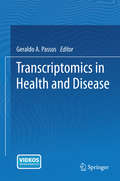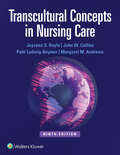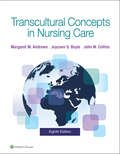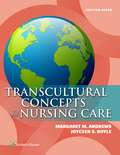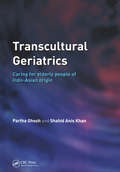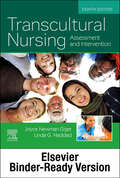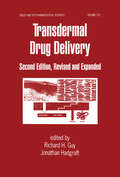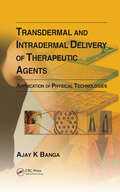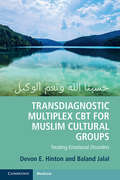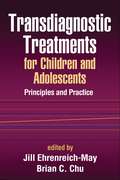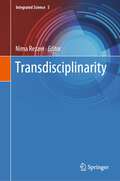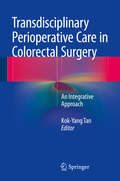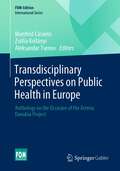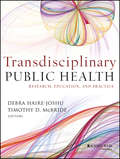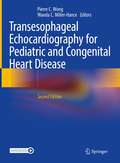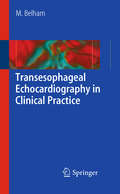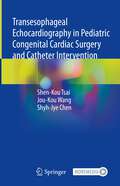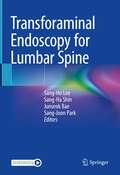- Table View
- List View
Transcriptional Regulation by Neuronal Activity: To the Nucleus and Back
by Ramendra N. Saha Serena M. DudekThis book discusses the regulation of gene transcription by neuronal activity that is evident in a large number of neuronal processes ranging from neural development and refinement of neuronal connections to learning and response to injury. Transcriptional Regulation by Neuronal Activity: To the Nucleus and Back, 2nd edition illustrates how signals are transmitted to the nucleus in response to neuronal activity, which genes are regulated and how this is achieved, and how these changes in gene expression alter neuronal function. The aim of this second edition is to highlight key advances in the field since the first edition. The book is divided into four sections. The first highlights how signals get to the nucleus from the membrane in response to synaptic or neuronal activity. Included are chapters on the pathways that transmit signals from synapses to nuclei. The second section focuses on epigenetic regulatory processes of activity-induced gene transcription, an area that has exploded in the past few years. The third section navigates the role of activity-induced genes in physiological processes such as learning and memory, and human developmental disorders such as those associated with the autism spectrum. The fourth section highlights groundbreaking technological advances in the field, which have allowed activity-regulated transcription to be used as a tool to study learning and memory.
Transcriptional and Epigenetic Mechanisms Regulating Normal and Aberrant Blood Cell Development
by Constanze Bonifer Peter N. CockerillDuring vertebrate hematopoiesis many specialized cell types are formed with vastly different functions such as B cells, T cells, granulocytes, macrophages, erythrocytes and megakaryocytes. To tightly control the enormous proliferative potential of developing blood cells, an intricately balanced signaling and transcription network has evolved that ensures that the different cell types are formed at the right time and in the right numbers. Intricate regulatory mechanisms ensure that blood cells function properly and have a determined life span. Moreover, in the adaptive immune system, long-lived memory cells have evolved that ensure that when pathogens have been seen once they will never cause a problem again. In this book we will therefore make a journey from asking how more primitive organisms use the epigenetic regulatory machinery to balance growth with differentiation control towards digging deep into what controls the function of specialized cells of the human immune system. We will first discover that flies make blood but exist without blood vessels, why fish make blood cells in the kidney and which precise genetic circuitries are required for these developmental pathways. We will then learn the regulatory principles that drive the differentiation of mature blood cells from stem cells and what controls their function in mammals. In the process, we will find out what unites hematopoietic stem cells and endothelial cells. Finally, we will shed light on the molecular mechanisms that either alter hematopoietic cell differentiation or lead to the development of cells with impaired function.
Transcriptional and Translational Regulation of Stem Cells
by Gary Hime Helen AbudThis volume describes the latest findings on transcriptional and translational regulation of stem cells. Both transcriptional activators and repressors have been shown to be crucial for the maintenance of the stem cell state. A key element of stem cell maintenance is repression of differentiation factors or developmental genes - achieved transcriptionally, epigenetically by the Polycomb complex, and post-transcriptionally by RNA-binding proteins and microRNAs. This volume takes two approaches to this topic - (1) illustrating the general principles outlined above through a series of different stem cell examples - embryonic, iPS and adult stem cells, and (2) describing several molecular families that have been shown to have roles in regulation of multiple stem cell populations.
Transcriptomics in Health and Disease
by Geraldo A. PassosAfter sequencing the human genome a decade ago, researchers have continued their projects, but now to try to better understand how, and when, genes are expressed in health and disease. Efforts have been concentrated on the measurement of the expression of RNA transcripts. In an analogy to the genome, the term "transcriptome" was created to refer to the complete set of RNAs in a cell type or tissue in a particular situation. Transcriptomics is the science that studies this issue and it is a branch of functional genomics. Transcriptomics in Heath and Disease provides a comprehensive overview of the science of transcriptomics initially in health, focusing on the concept of the transcriptome and the main methods to evaluate it. The authors discuss the concept and use of gene expression signatures and transcriptional biomarkers in normal development and diseased tissues and organs. As the transcriptome changes depending on the pathology, there is also a focus on the variations in the gene expression in different diseases such as autoimmune, inflammation, cancer and infections. This book should be very useful for researchers in molecular biology focusing on gene expression, human genetics, immunology, and genomics.
Transcultural Concepts in Nursing Care
by Joyceen S. Boyle Margaret Andrews John W. Collins Patti Ludwig-BeymerTranscultural Concepts in Nursing Care, 9th Edition, provides a contemporary framework for the safe, ethical, and effective care of diverse cultures and populations and cultivates the communication and collaboration skills essential to students’ success in today’s changing clinical nursing environment. Reflecting the expertise of established pioneers in the transcultural nursing field and incorporating the latest research and theoretical advances, the 9th Edition updates this proven approach to help students meet the healthcare challenges of an evolving cultural landscape.
Transcultural Concepts in Nursing Care (Coursepoint For Bsn Ser.)
by John Collins Joyceen S. Boyle Margaret AndrewsEnsure Culturally Competent, Contextually Meaningful Care for Every Patient Rooted in cultural assessment and trusted for its proven approach, Transcultural Concepts in Nursing Care is your key to ensuring safe, ethical and effective care to diverse cultures and populations. This comprehensive text helps you master transcultural theories, models and research studies while honing the communication and collaboration skills essential to success in today’s changing clinical nursing environment. Updated content familiarizes you with changes in the healthcare delivery system, new research studies and theoretical advances. Evidence-Based Practice boxes ground concepts in the latest research studies and highlight clinical implications for effective practice. Case Studies , based on the authors’ actual clinical experiences and research findings, help you translate concepts to clinical applications across diverse healthcare settings. Review questions and learning activities in each chapter inspire critical thinking and allow you to apply your knowledge. Chapter objectives and key terms keep you focused on each chapter’s most important concepts.
Transcultural Concepts in Nursing Care (Seventh Edition)
by Margaret M. Andrews Joyceen S. BoyleThe text helps nursing students transform their thinking so they develop into culturally competent nurses capable of safe, thoughtful, and ethical care of individuals, families, groups, and communities of diverse backgrounds. It provides a framework that will improve health and nursing care to minority, underrepresented, disenfranchised, and marginalized populations. The authors provide students the tools they will need as nurses to effectively perform cultural assessments and incorporate their findings into their interventions. With more culture specific examples in this edition, the text offers the knowledge needed to provide culturally competent and contextually meaningful care for all clients. Fully updated in its seventh edition, this resource creates an interdisciplinary knowledge foundation reflecting the cultural changes in the clinical nursing environment.
Transcultural Geriatrics: Caring for the Elderly of Indo-Asian Origin
by Partha Ghosh Shahid Anis KhanIncludes colour illustrations This practical reference draws together the combined expertise of a wide range of health professionals in managing this condition. Their work is soundly based on recent research into its pathology manifestations and treatment to develop appropriate management strategies. Part of the value in this book lies in its reference to patient perspectives and how they can contribute to the most effective care.
Transcultural Nursing
by Joyce Newman Giger Linda G. HaddadNEW co-author Dr. Linda Haddad is an internationally recognized cultural scholar who has taught nursing around the globe, has acted as an advisor and coordinator for the World Health Organization, and has published over 30 scholarly articles on nursing with a focus on understanding the cultural implication to care. <P><P> UPDATED! Cultural chapters are completely revised to reflect the shifting experiences of cultural groups in our society.
Transdermal Applications of Minimally Invasive Drug Delivery Systems: Current Trends and Future Perspectives
by Vandana B. Patravale Kamal Dua Sachin Kumar Singh Monica Gulati Malakapogu Ravindra Babu Hélder SantosThis book presents the scientific as well as industrial perspectives, challenges, and advances in minimally invasive drug delivery systems for topical applications. It also covers the regulatory requirements and specifically discusses all the intellectual property rights filed and granted throughout the globe for minimally invasive systems. This book presents detailed analyses of various minimally invasive drug delivery methods as well as the recent advances in devices such as microneedles, iontophoretic devices, probes, etc. This book will be of keen interest to a wide range of audiences, including clinical researchers working in the field of drug delivery and disease diagnosis, as well as undergraduate and postgraduate students from various disciplines such as pharmacy, pharmacology, pharmaceutics, biotechnology, and health sciences.
Transdermal Drug Delivery Systems: Revised and Expanded
by Jonathan HadgraftPresents authoritative state-of-the-art discussions of the key issues pertinent to transdermal drug delivery, examining those topics necessary to enable a critical evaluation of a drug candidate's potential to be delivered across the skin; from physical chemistry and assessment of drug permeability to available enhancement technolgies, to regulator
Transdermal and Intradermal Delivery of Therapeutic Agents: Application of Physical Technologies
by Ajay K BangaSkin, once thought to be an impenetrable barrier, is an extremely active organ capable of interacting with its environment. Advancements in science combined with the need for diverse drug delivery modalities have introduced a variety of transdermal and intradermal products for existing drugs at a fraction of the cost of new drug development. Interest in drug delivery systems is growing as the delivery of many drugs continues to be a problem due to safety, stability, and compliance issues. This is especially true for the increased number of biologic medicines, which include peptides, proteins, and nucleic acids. Transdermal delivery is an important part of such systems, and the use of physical enhancement methods to penetrate the skin barrier is where the field is headed. This book reviews the strategies available for the delivery of compounds into and through the skin. It also focuses on technological developments in the domain of nanotechnology that can be exploited to enhance the transdermal delivery of drugs.
Transdiagnostic Multiplex CBT for Muslim Cultural Groups: Treating Emotional Disorders
by Devon E. Hinton Baland JalalWith an increasing number of Muslims living in the West, and studies suggesting that mental illness may be more prevalent and chronic amongst Muslim cultural groups, there is a pressing need for appropriate treatment options. This book provides mental health professionals with a practical guide to delivering culturally adapted therapy to Muslim immigrants, refugees, and those with a Muslim religious or cultural background. It takes into account the religious, spiritual, social and cultural dimensions of individuals, framing elements such as mindfulness, emotion regulation and sleep problems within well-known Islamic terms and concepts. The book covers issues such as prominent somatic symptoms, multiple comorbidities, low education, ongoing life difficulties and mental health stigma. As Multiplex Therapy is transdiagnostic, targeting anxiety and mood disorders, the treatment is applicable to a large proportion of patients. Each chapter guides the reader through therapy sessions, giving clinicians an invaluable everyday manual for delivering treatment.
Transdiagnostic Treatments for Children and Adolescents
by Brian C. Chu Jill Ehrenreich-MayThis volume presents cutting-edge advances in case conceptualization and intervention for children and adolescents, who typically present for mental health treatment with multiple, overlapping problems. Leading clinician-researchers examine common processes--including stress and coping, attention and interpretation biases, avoidant behaviors, and peer and family interactions--that underlie the development and maintenance of diverse forms of psychopathology. They describe exemplary treatments that target these processes and can be used across diagnostic categories. Chapters on specific treatment protocols address the theoretical foundations, clinical strategies used, which patient populations each treatment is suitable for, and the status of the empirical evidence base.
Transdisciplinarity (Integrated Science #5)
by Nima RezaeiThis contributed volume book aims at discussing transdisciplinary approaches to address common problems. By working transdisciplinarily, researchers coming from different disciplines can work jointly using a shared conceptual framework bringing together disciplinary-specific theories and concepts. There are numerous barriers that can obstruct effective communication between different cultures, communities, religions and geographies. This book shows that through bringing together different disciplines, researchers not only can surpass these barriers but can effectively produce new venues of thought that can positively affect the development and evolution of research and education. The book discusses new and emerging applications of knowledge produced by transdisciplinary efforts and covers the interplay of many disciplines, including agriculture, economics, mathematics, engineering, industry, information technology, marketing, nanoscience, neuroscience, space exploration, human-animal relationships, among others. Consequently, it also covers the relationship between art and science, as one of the most remarkable transdisciplinary approaches that paves the way for new methods in engineering, design, architecture and many other fields.
Transdisciplinary Perioperative Care in Colorectal Surgery
by Kok-Yang TanThe field of colorectal surgery has undergone tremendous developments in recent decades. Surgery has become less invasive, new perspectives and insights have improved perioperative management and novel outcome measures have been defined. At the same time, the limits of surgical technique and perioperative care are being challenged by more complex patients. In order to realize the immense potential for excellent outcomes in colorectal surgery, coordinated multifaceted care must be delivered within a context of limited resources. Accordingly, there is a pressing need to streamline processes and heighten clinical productivity. Excellent communication and collaboration are required, with constant attention to detail and precision within an environment of learning, research and innovation. This book discusses in depth the transdisciplinary integration of different components of care in colorectal surgery. Pertinent background information on the complexities of current management in colorectal surgery is first provided, followed by discussion of the role of design thinking in care integration. Subsequent chapters focus on a range of issues associated with surgical and perioperative care in patients undergoing colorectal surgery, with emphasis on how the multiple facets of care can be integrated through a transdisciplinary approach. Each chapter provides helpful take-home messages in bullet point form and numerous informative figures and tables are also included. The authors are surgeons, physicians, anesthetists, oncologists, nurses, and allied health professionals with extensive experience in the field.
Transdisciplinary Perspectives on Public Health in Europe: Anthology on the Occasion of the Arteria Danubia Project (FOM-Edition)
by Manfred Cassens Zsófia Kollányi Aleksandar TsenovIn recent decades, policymakers all over the world have sought to strengthen the meaning and effect of public, non-medical healthcare. This publication is the result of the research initiation project »Arteria Danubia ‒ Analysis and Discussion on the Implementation of Model Health Regions in the Upper and Lower Reaches of the Danube« (2017 to 2019), which focused on healthcare in Bulgaria, Germany and Hungary. In this book, researchers from the participating universities and organizations explore the topic of public health in all its facets: How can public policy and education influence people’s health? How are lifestyle-related diseases to be avoided? And how best to implement digital healthcare solutions?
Transdisciplinary Public Health
by Timothy D. Mcbride Debra Haire-Joshu"This book makes a great leap in the conceptualization of transdisciplinary approaches, as well as provides concrete examples in practice, teaching, policy, and research."-From the Foreword by Edward F. Lawlor, dean and the William E. Gordon Distinguished Professor, the Brown School; and founding director, Institute for Public Health at Washington University in St. LouisThe complexity of public health and social problems is becoming more challenging. Understanding and designing solutions for these problems requires perspectives from multiple disciplines and fields as well as cross-disciplinary research and practice teams. Transdisciplinary Public Health fills a void in the literature and offers a comprehensive text that introduces transdisciplinary methods as a means for providing an innovative tool set for problem-solving in public health research and practice.With contributions from leading experts, Transdisciplinary Public Health offers an understanding of interactions among the biological, behavioral, social, and public health sciences; shared disciplinary frameworks in analyzing health problems; and the integration and evaluation of transdisciplinary solutions to alleviate complex public health issues. Use of this important resource will promote transdisciplinary research and practice, resulting in novel solutions that positively impact human health.
Transesophageal Echocardiography Multimedia Manual: A Perioperative Transdisciplinary Approach
by Annette Vegas Pierre Couture Jean-Claude Tardif Jean Buithieu André Y. DenaultThis second edition of the Transesophageal Echocardiography Multimedia Manual is a comprehensive resource and essential guide to the rapidly expanding field of perioperative transesophageal echocardiography (TEE), encompassing newer cardiac surgery techniques, more diverse surgical procedures, and use in the intensive care unit. With over 900 figur
Transesophageal Echocardiography for Congenital Heart Disease
by Wanda C. Miller-Hance Pierre C. WongTransesophageal Echocardiography for Congenital Heart Disease represents a unique contribution as the only contemporary reference to focus exclusively on the clinical applications of transesophageal echocardiography (TEE) in congenital heart disease (CHD). Written by numerous prominent specialists and renowned leaders in the field, it presents a comprehensive, modern, and integrated review of the subject in light of the cumulative experience and most recent advances in the technology. Topics related to CHD include: (1) physics and instrumentation of TEE, particularly as they apply to the structural evaluation; (2) specialized aspects of the examination, with emphases on technical considerations pertinent to both pediatric and adult patients with congenital cardiovascular pathology; (3) segmental approach to diagnosis and functional assessment; (4) extensive discussion of the TEE evaluation of the many anomalies encompassing the CHD spectrum; (5) use of the imaging modality in the perioperative and interventional settings; and (6) important aspects of 3D TEE evaluation. Richly illustrated by more than 700 figures/illustrations and 400 videos, this textbook will serve as an indispensable resource for all who use TEE in the care of both children and adults with CHD, from the novice to the expert.
Transesophageal Echocardiography for Pediatric and Congenital Heart Disease
by Wanda C. Miller-Hance Pierre C. WongThis extensively revised textbook reviews the use of transesophageal echocardiography (TEE) in pediatric and young adult patients with cardiac disease. It reviews how TEE has made a vital contribution to these patients’ successful and continually improving clinical outcomes, enabling them to live well into adulthood. The book details the evolving technology and applications of TEE (including three-dimensional TEE), describing how this imaging approach remains at the forefront of clinical practice for pediatric patients and those with congenital heart disease (CHD). Transesophageal Echocardiography for Pediatric and Congenital Heart Disease represents a unique contribution as the only contemporary text to focus exclusively on the clinical application of TEE in children and all patients with CHD. Written by numerous prominent specialists in the field, it presents a comprehensive, modern and integrated review of the subject. Specific chapter topics include the physics and instrumentation of TEE, structural and functional evaluation, and specialized aspects of the examination, with emphasis on the technical considerations pertinent to both pediatric and adult patients with a variety of congenital and acquired cardiovascular pathologies. Consequently, it serves as a comprehensive reference for the TEE evaluation of CHD, utilizing the segmental approach to diagnosis and discussing the TEE evaluation of the many anomalies encompassing the CHD spectrum. In addition, numerous other relevant topics are discussed, including application of TEE for perioperative and interventional settings. The book is richly illustrated, with many chapters supplemented by illustrative case studies and accompanying videos. A specific section with multiple-choice questions and answers is provided at the end of each chapter to reinforce key concepts. This textbook therefore provides an invaluable and indispensable resource for all trainees and practitioners using TEE in the management of CHD and pediatric patients.
Transesophageal Echocardiography in Clinical Practice
by Mark BelhamOver the last 30 years the technological advances in TEE have been exponential and have been reflected by its increasing utilization. Currently almost all echocardiography labs undertake TEE and the vast majority of valve operations are performed with TEE guidance. When imaging a patient's heart the number of modalities available to choose from seems to be ever increasing and the clinician needs to be aware of the strengths and weaknesses of each modality in order to best answer the question posed. Those in cardiac imaging know that the spatial and temporal resolution of the modality is unsurpassed and that it is relatively easy to get good images with minimal training. The purpose of this book is thus to give practical guidance to those undertaking training in the art of TEE. It is not an exhaustive text to be used for reference but one that should be used in conjunction with hands-on experience. If used correctly it will help in realizing the true potential of TEE.
Transesophageal Echocardiography in Pediatric Congenital Cardiac Surgery and Catheter Intervention
by Shen-Kou Tsai Jou-Kou Wang Shyh-Jye ChenThis book reviews the history and evolution of intraoperative transesophageal echocardiography (TEE) as applied in various pediatric congenital heart surgeries, catheter intervention procedures and hybrid surgeries. The development of the pediatric TEE is described, including safety and efficacy data in infants and neonates. Practical insights of the use of TEE in cardiac surgery and catheter intervention are highlighted through actual case presentations with images and illustrations. Topics covered include TEE monitoring from pre-procedural planning, real-time assist during the surgery, confirmation of the intended results, as well as identification of residual lesions that require further surgical correction. This book will be a valuable resource for practitioners working in the field of pediatric congenital heart diseases surgery and interventional procedures where TEE plays a vital role.
Transfer RNA in Protein Synthesis
by Dolph L. HatfieldTransfer RNA in Protein Synthesis is a comprehensive volume focusing on important aspects of codon usage, selection, and discrimination in the genetic code. The many different functions of tRNA and the specialized roles of the corresponding codewords in protein synthesis from initiation through termination are thoroughly discussed. Variations that occur in the initiation process, in reading the genetic code, and in the selection of codons are discussed in detail. The book also examines the role of modified nucleosides in tRNA interactions, tRNA discrimination in aminoacylation, codon discrimination in translation, and selective use of termination codons. Other topics covered include the adaptation of the tRNA population to codon usage in cells and cellular organelles, the occurence of UGA as a codon for selenocysteine in the universal genetic code, new insights into translational context effects and in codon bias, and the molecular biology of tRNA in retroviruses. The contributions of outstanding molecular biologists engaged in tRNA research and prominent investigators from other scientific disciplines, specifically retroviral research, make Transfer RNA in Protein Synthesis an essential reference work for microbiologists, biochemists, molecular biologists, geneticists, and other researchers involved in protein synthesis research.
Transforaminal Endoscopy for Lumbar Spine
by Sang-Ho Lee Junseok Bae Sang-Ha Shin Sang-Joon ParkEndoscopic spine surgery is the essence of the minimally invasive surgery technique. It’s a gradually developing field of spine surgery. Nevertheless, many doctors still have difficulties in acquiring an endoscope by themselves. This is especially true for transforaminal approach endoscopy. The editors of the book are pioneers in endoscopy and have had many interesting experiences related to transforaminal endoscopy. Since each patient has a different anatomy and disc shape, there are numerous practical techniques suitable for it, but few are specifically able to describe it. The main purpose of this book is to provide the essence of endoscopy to date, based on actual video images and practical techniques of transforaminal endoscopy accumulated over decades.



